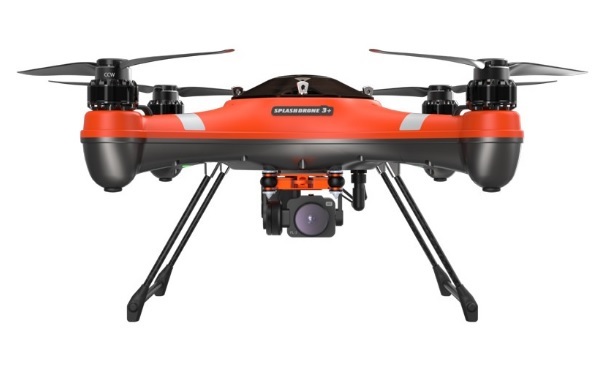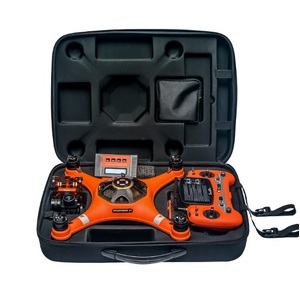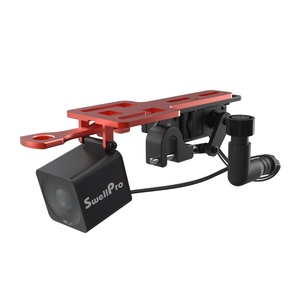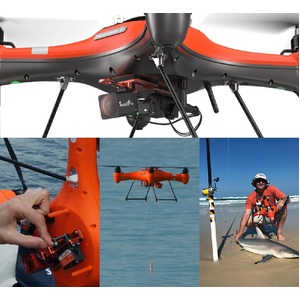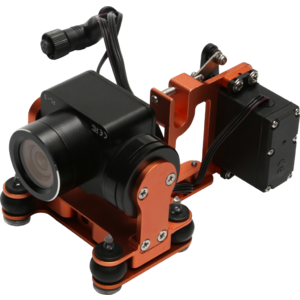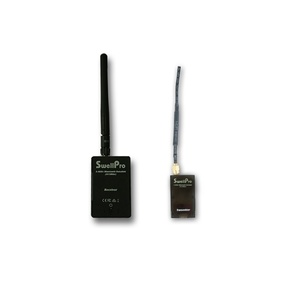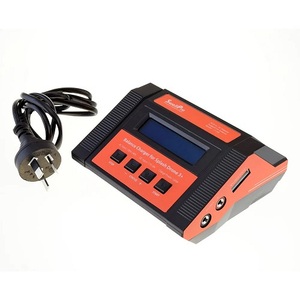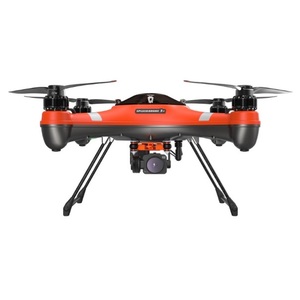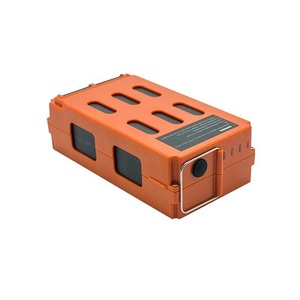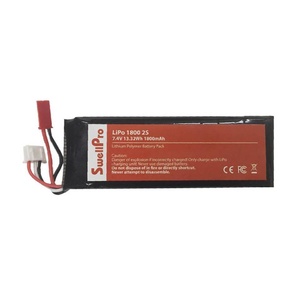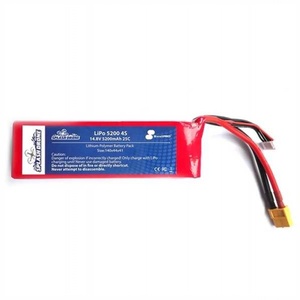Splash Drone 3+ Fisherman Pack - Waterproof GPS FPV Fishing Drone
New and Improved Splash Drone 3+ Fisherman Pack
SKU: TR3328
Splash Drone 3 + Waterproof Drone - Fisherman Pack
New and Improved Splash Drone 3+ Fisherman Pack
The Swellpro Splash Drone 3+ Fisherman Pack is supplied with the Splash Drone 3+ Drone with a PL2 Waterproof HD Camera with Payload Release Mechanism. The perfect kit for the serious Fisherman.
Important Note:
If you want to use the Autonomous Flight features - APP Control, follow the link for the Autonomous Flight Ground Station Radio Module: Autonomous Ground Station module
PL2 camera is for live-view only, does not record or take images
Enhancing and extending the features of the previous SplashDrone 3 ,the latest SplashDrone 3+ is the most reliable and versatile waterproof drone yet .
Coupled with several different payloads such as Cameras and Payload Release Mechanisms .SplashDrone 3+ can be adapted for a wide variety of uses .It is an all purpose,all weather,waterproof flying platform.
Waterproof SplashDrone 3+ : One platform, many possibilities
The SplashDrone 3+ Platform standard package content
1 x SplashDrone 3+ main body
1 x PL2 waterproof HD Camera with Payload Release
1 x FPV Remote Controller
1 x set of 1242 propellers ( Two pairs )
1 x Balance Charger
1 x 5200 mAh LiHV Drone battery
1 x Radio battery
1 x set of Landing Gear
1 x Aircraft User Manual
1 x Carry case
CLICK HERE TO SEE OTHER FISHING DRONES IN OUR RANGE
Disclaimer:
Orders for products valued over $500 is subject to identification check prior to dispatch. We will contact you to request for a copy of your ID in order to release your order for dispatch.
N.B.:
- "Same Day Dispatch" guarantee is not available for this item
- May not be available at our Product Showroom for purchases or Pick Ups
Please contact us if you have any questions
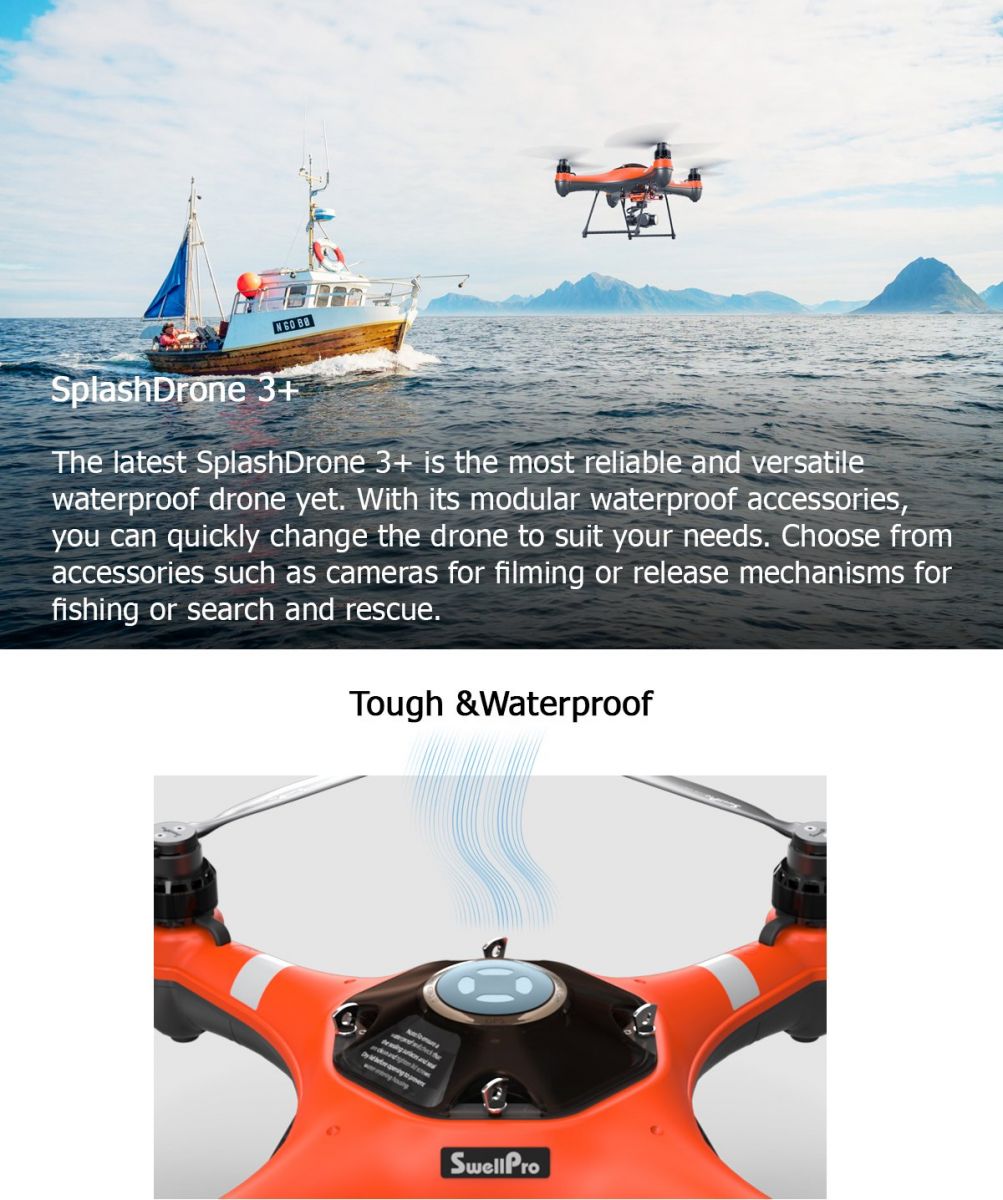
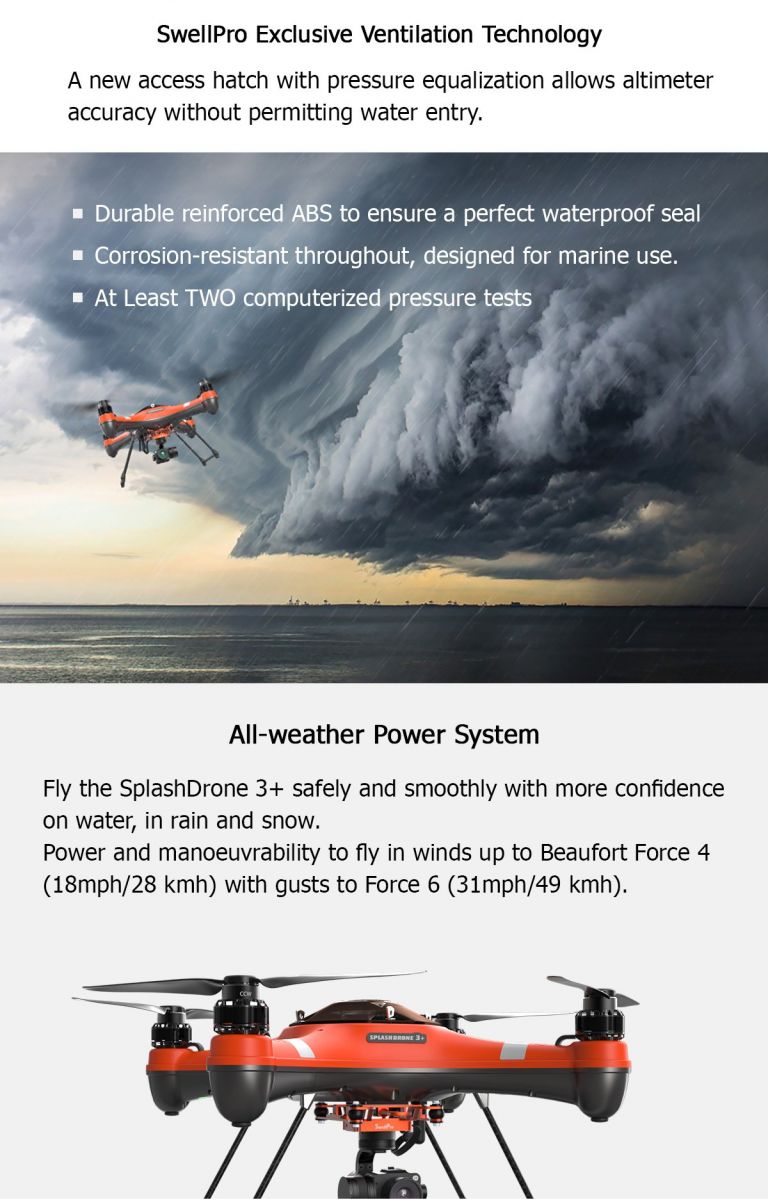
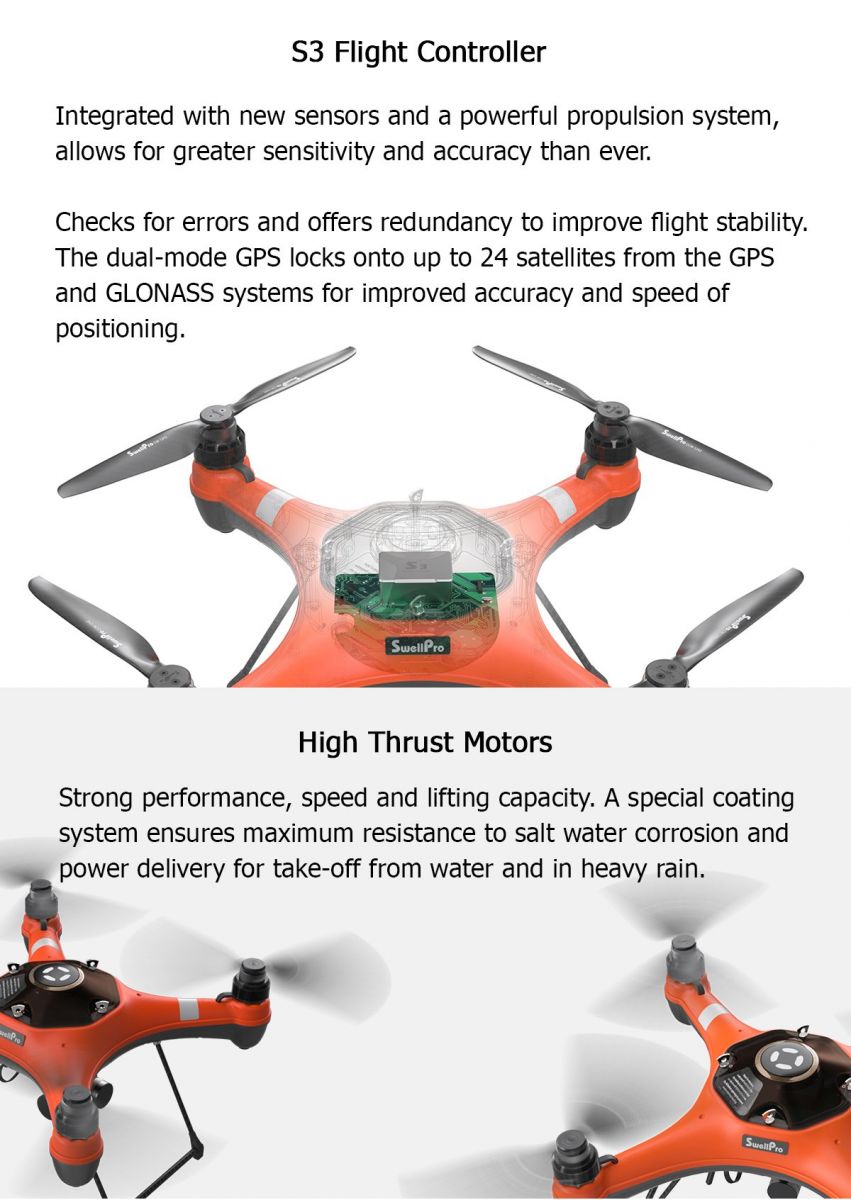
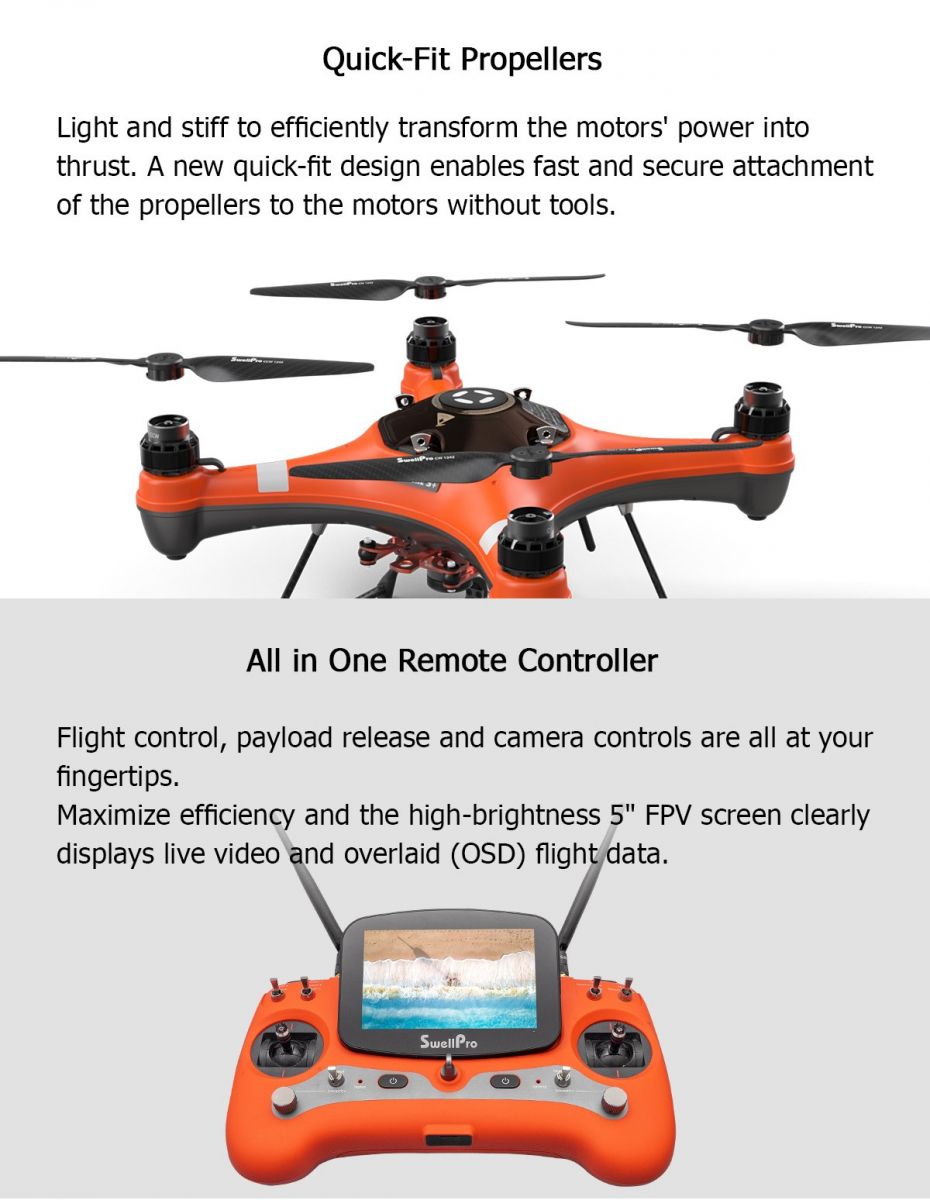
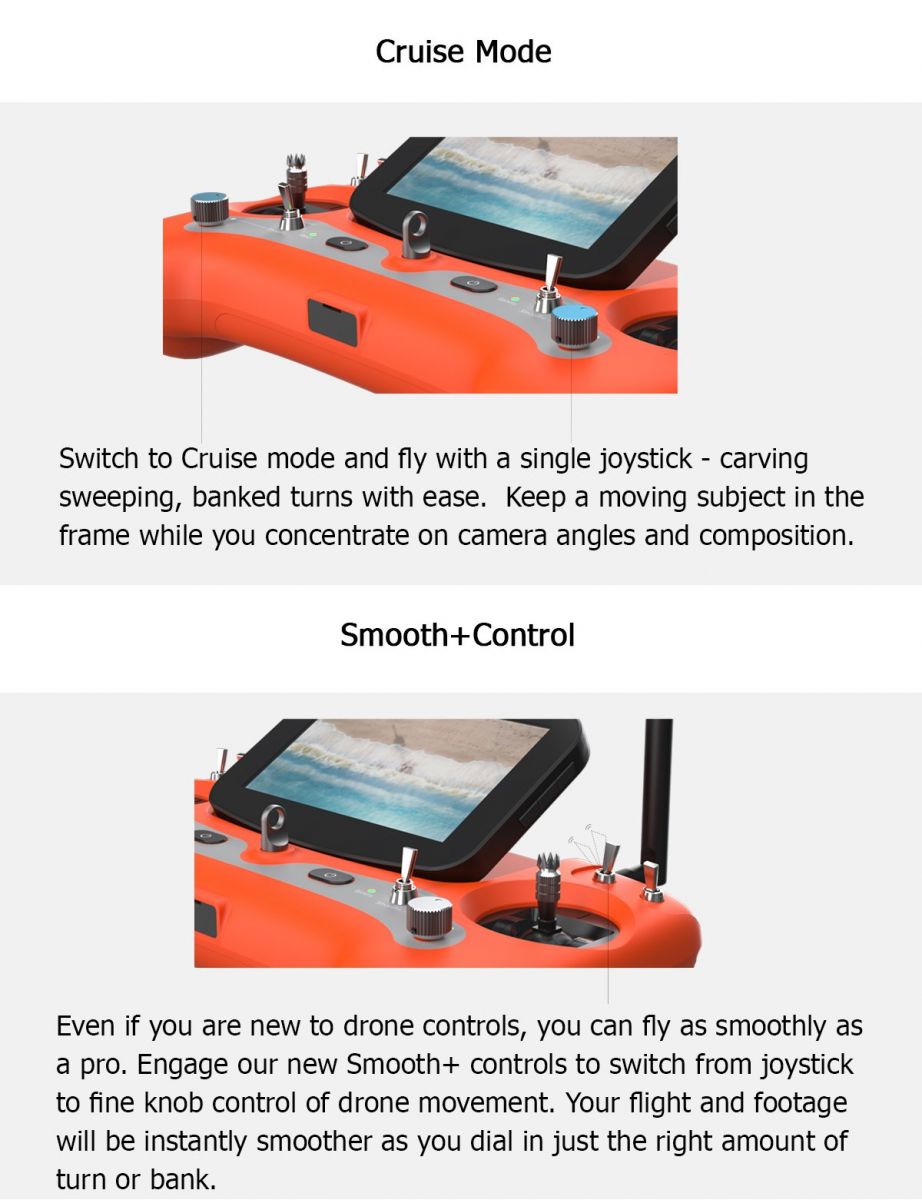
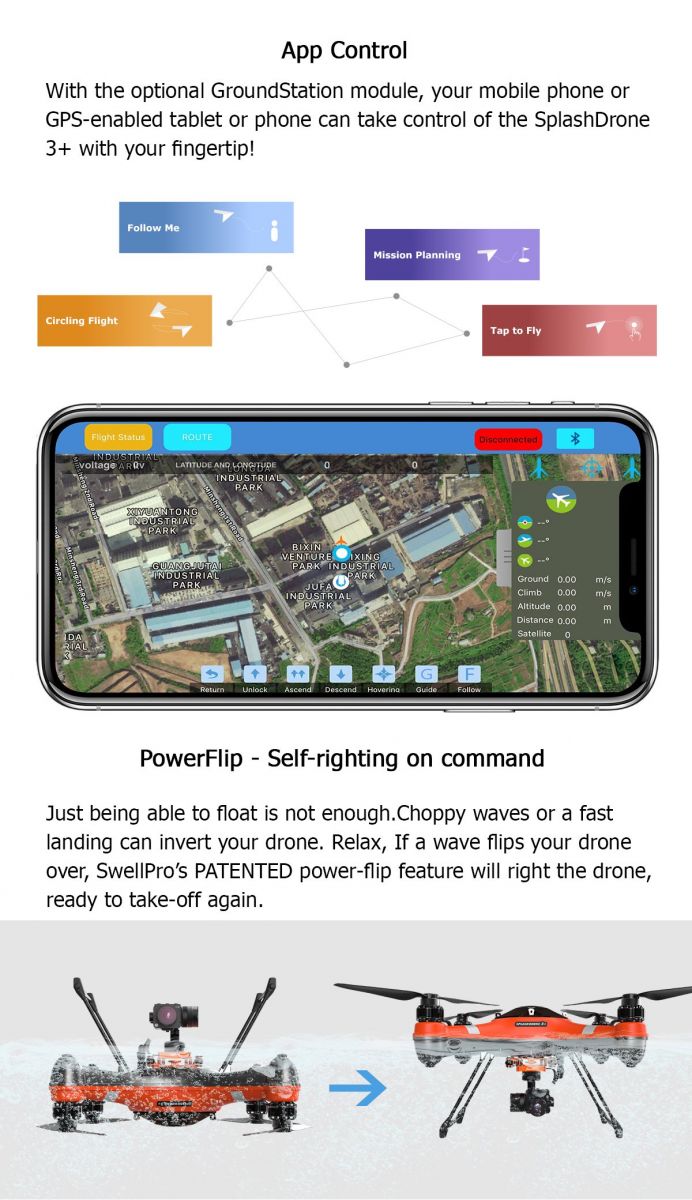
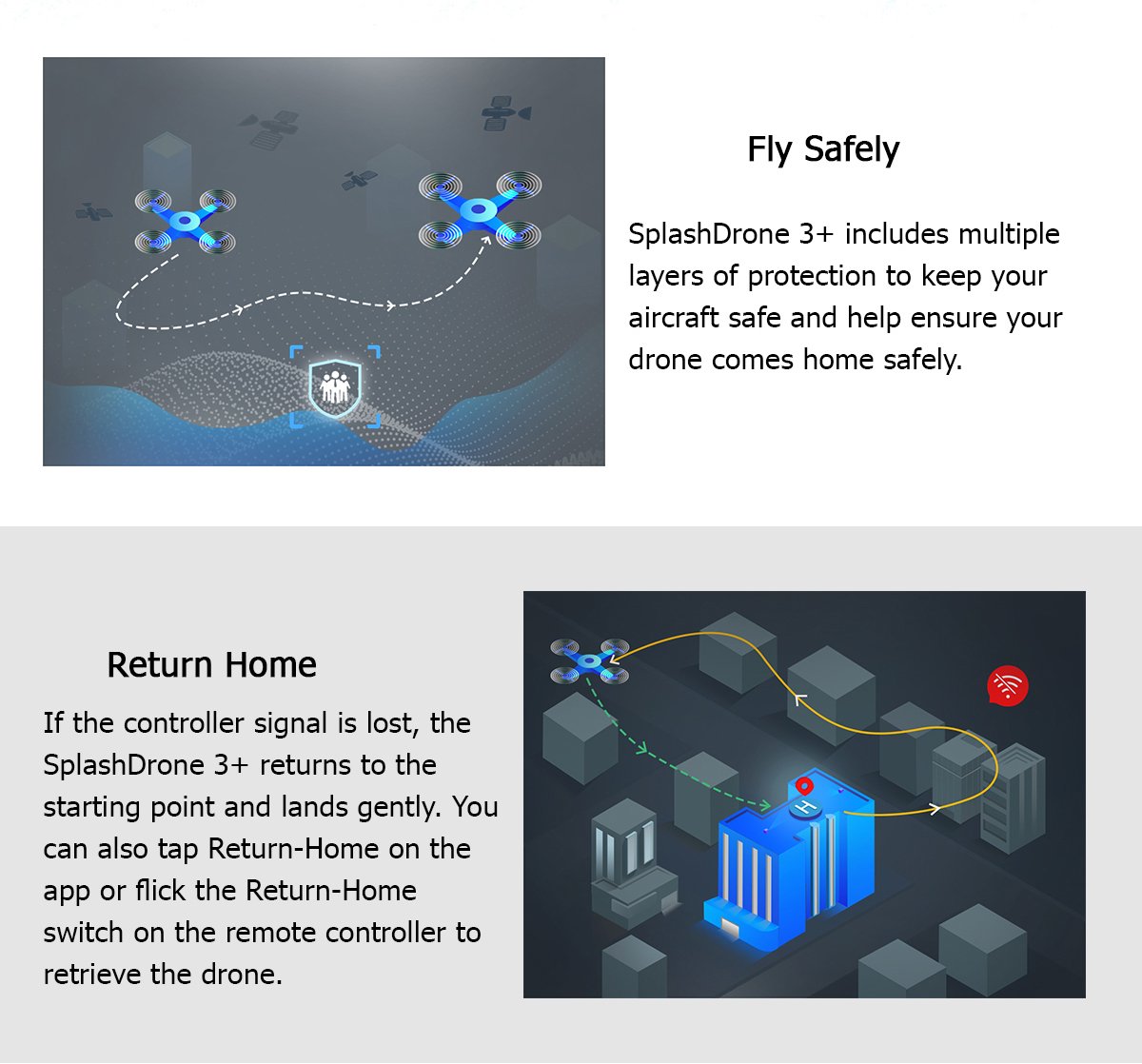
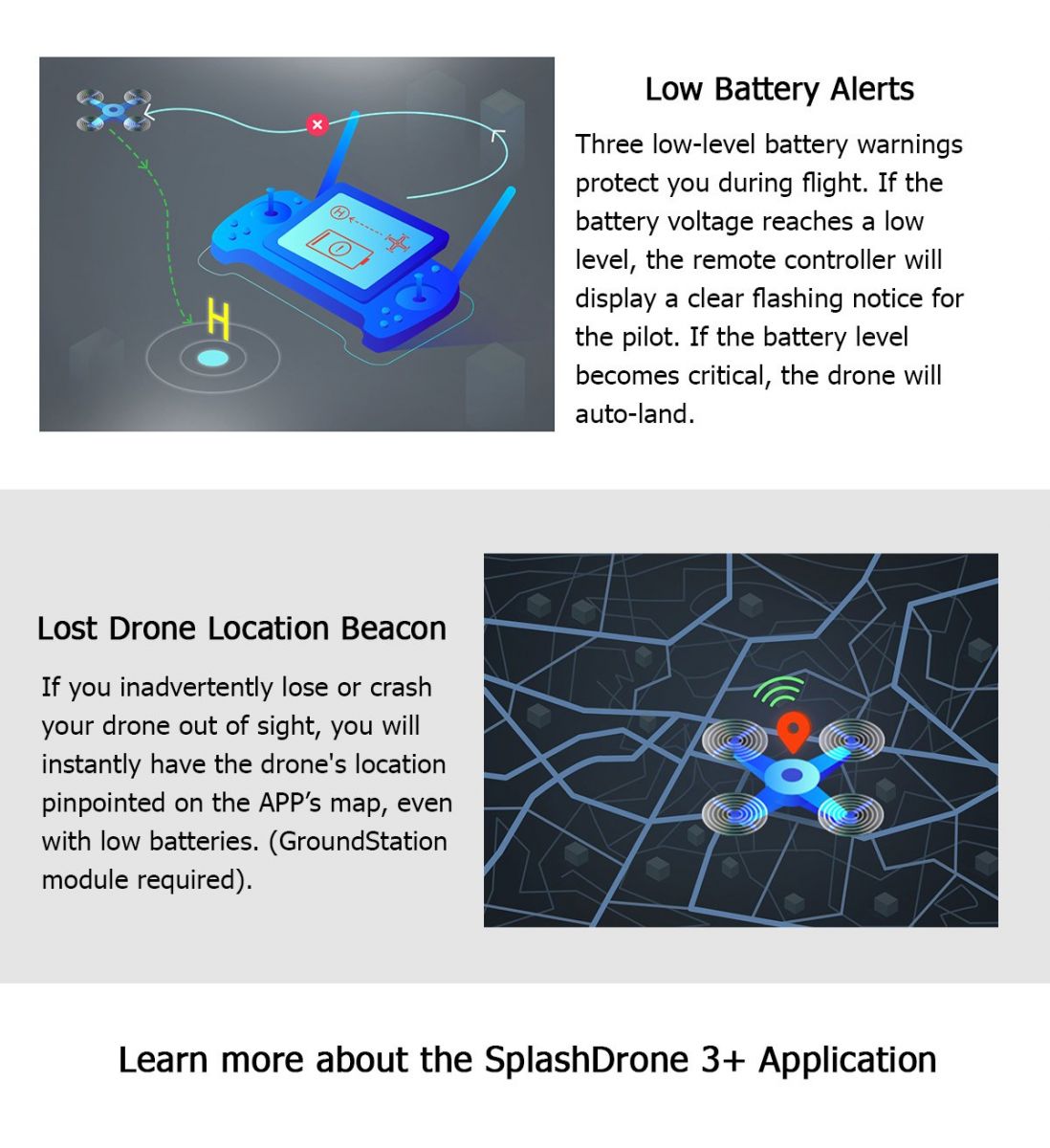
CLICK HERE TO SEE OTHER FISHING DRONES IN OUR RANGE
CLICK HERE TO SEE OTHER DRONES IN OUR RANGE
1. Battery Use
- Do not allow the batteries to come into contact with any kind of liquid.- Do not drop the battery into water.
- Do not leave batteries out in the rain, or near a source of moisture. If the inside of the battery comes into contact with water, chemical decomposition may occur, potentially resulting the battery catching on fire, and may even lead to an explosion.
- Never use non-Swellpro batteries. New batteries can be purchased by going to www.swellpro.com, or through your local Swellpro dealer. Swellpro takes no responsibility for any damage or injury caused by using non-SwellPro batteries.
- Never use or charge swollen, leaky or damaged batteries. If your batteries are abnormal, please contact Swellpro, or a Swellpro authorized dealer for further assistance.
- The battery can be used in the temperatures ranging from -10°C to 40°C. Use of the battery in environments above 50°C can lead to a fire or explosion. Use of the battery below -10°C can lead to permanent damage.
- Never disassemble, or penetrate the batteries with sharp tools, otherwise, this may result in the battery catching fire, or even lead to an explosion.
- Electrolytes in the battery are highly corrosive. If any electrolytes make contact with your skin or eyes, immediately wash the affected area with fresh running water for at least 15 minutes, and then see a doctor immediately.
- If the battery falls into water, pick it up immediately and put it in a safe and open area. Maintain a safe distance from the battery until it is completely dry. Never use the battery again, and dispose of the battery properly as described in the Battery Disposal section below.
- Do not heat batteries. A battery fire can be extinguished using sand, or a dry powder fire extinguisher.
- Do not put batteries in a microwave oven, or in a pressurized container.
- Do not put the loose battery cells onto any conductive surface, such as a metal table.
- Do not put any conductive cables or metal objects together with batteries, where they may short-circuit against each other. - Do not drop or strike batteries.
- Do not place heavy objects on the batteries or the battery charger.
- Clean battery terminals with a clean, dry cloth. Failure to do so may result in poor electrical contact, which could reduce the battery capacity, or damage the charger.
- Do not continue to fly the drone after the low battery alarm has been activated; this will result in over-discharging the battery, and potentially could damage the battery cells.
2. Battery Charging
- Always use a Swellpro approved charger to charge the battery of the drone, and the radio controller. Swellpro takes no responsibility if the battery is charged using a non-Swellpro charger.
- In order to avoid any potential accidents happening, please do not leave the battery charging unattended.
- Do not charge the battery near flammable materials, or on flammable surfaces, such as carpet or wood.
- Do not charge battery immediately after flight, because the battery temperature may be too high.
- Disconnect the charger when not in use. Examine and maintain the charger regularly.
- Do not clean the charger with denatured alcohol or other flammable solvents.
- Never use a damaged charger.
3. Battery Storage and Transportation
- Keep batteries out of the reach of children and pets.
- Do not leave the battery near heat sources, such as a furnace, heater, or exposure to strong direct sunshine, for example: in cars.
- The ideal storage temperature is 22°C ~ 28°C.
- Keep the battery in a dry and ventilated environment
- Never drop the battery into water, or store it in places where there is a possibility of water leakage.
- Do not drop, strike, impale, pierce, or manually short-circuit the battery.
- Keep the battery away from metal objects, such as watches, jewelry, and hairpins.
- Never transport a damaged battery, or a battery with power level higher than 50%.
- Do discharge the power to 50% or less before transportation.(The suggested battery voltage level of the drone is around 15.8V, and the radio controller is 7.9V)
- Do discharge the power to 50% or less when you are not going to use the drone in the coming days.
4. Battery Maintenance
- Never use the battery when the temperature is too high or too low.
- Never store the battery in environments with a temperature higher than 60°C .
- Do discharge the power to 50% or less when you are not going to use the drone in the coming days.
- Never store the battery for a long time after use. If need to store for long time, need to fully charge the battery and then discharge to less than 50% every one month. Otherwise the battery will become over-discharged, and ruin the battery.
- Never over dis-charge the battery, otherwise the battery cells will be damaged.
- Do not charge battery immediately after flight, because the battery temperature may be too high.
Correct Use and Maintenance Methods of Drone batteries
I. Don’t over discharge drone batteries.
Fast drop of battery voltage will lead to over discharge with bad control, which will cause slight damage to the battery, and even cause the crash of drones with since the voltage is too low. Some flyers always get batteries over discharged since they have fewer batteries, which is shortening the battery life each time. Each minute you save during the fly will save the battery one more cycle of life. It is better to buy two more batteries and never push to the limit each time. So flyers strictly should follow flying requirements of battery, when low battery warning shows, flyers should land it as soon as possible.
II. Don’t over charge drone batteries.
The auto power off function of some chargers is not perfect. It would keep monolithic batteries being charged with high voltage of 4.35 V to 4.2 V, in stead of being stop charging. In addition, aging components will also cause the same problem with a period of time of using. Over charged drone batteries will cause poor battery life, or cause explosion and fire in the worst case Therefore, to prevent lithium battery overcharge, the following points should be noted:
1. Use professional or manufacturer-made intelligent balance charger.
2. Accurately set the number of individual batteries in the battery pack.
3. Periodically test the single cell voltage of the battery pack to ensure the voltage balance of the battery pack.
4, charge according to the regulation C number of charge, no care do not charge.
III. Store drone batteries not fully charged
Chemical properties of fully charged batteries are extremely active, and the batteries can not be stored more than 3 days, if more than a week with discharging it, there is a risk of gas leakage, some batteries may not temporarily be swollen, but after a few times of storage like this, the batteries may be directly scrapped. Therefore, users or flyers should always charge before use. If the battery not being used after charging, discharge the battery to the single voltage within 3 days after full charge with single cell voltage from 3.80 V to 3.85 V, which can extend the battery life.
Iv. Safe placement of drone batteries
1.Handle with care. The exterior of the battery pack is an important structure to prevent battery explosion and leakage fire. The damage of the exterior of the battery will directly lead to large self-discharge, low voltage and serious fire or explosion. The battery should be handled gently, when fixing the battery on the drone, the belt should be tight. Because it is possible to cause large dynamic flight or by external forces and other operations fall machine, the battery is not tied tightly and knock or throw off or, easy to cause damage to the battery.
2, Do not charge and discharge in high/low temperature environment. Extreme temperature will affect the performance and life of the battery. Before charging users should check whether the used battery has been cooled down, do not charge and discharge in the cold garage, basement, direct sunlight or near the heat source.
3, The battery should be stored in a cool environment. For long-term storage of the battery, the recommended ambient temperature is 10~25°C, dry and non-corrosive gas.
V. Safe transportation of drone batteries
Avoid the Batteries from collision and friction. Since transportation collision may cause short circuit of the battery external equalization line, which will directly lead to battery fire or fire explosion. At the same time, the conductive material should be avoided from contacting the positive and negative electrode of the battery and short-circuit. During transportation, the best way is to put the battery into a single bubble bag and put it into a separate box.
VI. In the use of drone battery, the voltage of a single cell is rated at 3.7v, while the high-voltage cell is rated at 3.8v. The actual voltage of a single lithium cell is 3.0-4.2v, while the actual voltage of a high-voltage lithium cell is 3.0-4.2v. The safe voltage is 3.0-4.35v and Lithium batteries must be kept in this range. If the voltage is lower than 3.0 V, it will cause slight discharge, and if it is lower than 2.8 V, batteries will be excessively discharged, which will cause lithium battery swollen, and internal chemical liquid crystallized, and the crystal may pierce the internal structure layer and cause short circuit, and even drop the lithium battery voltage to zero volts. When charging a single cell with voltage higher battery than 4.2 V or high voltage battery 4.35, which is defined as overcharging. The fierce internal chemical reaction will cause the lithium battery swollen, and if it continues being overcharged, it will cause burning. So be sure to use security standard normal charger and a manufacturer of custom matching the charger to charge the battery, at the same time it is strictly prohibited to privately refitting of charger, it may cause serious consequences, for flight safety, monolithic alarm can be set for 3.6 3.65 V voltage, such as the voltage, or close to the voltage, the user or fly hand action will be executed immediately return or landing, do a good job in security van prevention measures, as far as possible to avoid the battery discharge, or bombing as a result of insufficient battery discharge voltage.
7. Lithium battery used at low temperature
In cold weather or high altitude, if the battery is placed outdoor for a long time, its discharge performance will be greatly reduced. if it is flying under the operation of normal temperature, the battery cannot be sent out at room temperature under the condition of electricity, the alarm should be the voltage (such as single chip alarm voltage to 3.8 V) because the press drop will be very fast in low temperature environment, alarm rang down immediately. The battery should be kept in a warm environment before taking off, such as in the house, in the car, and in the incubator. To take off, install the battery quickly, and perform the flight mission, try to reduce the time to half of the normal temperature when flying at low temperature, so as to ensure safe flight.
| SKU | TR3328 |
| Barcode # | 9351634011513 |
| Brand | Swell Pro |
| Shipping Weight | 20.0000kg |
| Shipping Width | 0.500m |
| Shipping Height | 0.300m |
| Shipping Length | 0.400m |
| Shipping Cubic | 0.060000000m3 |
| Unit Of Measure | ea |
Be The First To Review This Product!
Help other Aus Electronics Direct users shop smarter by writing reviews for products you have purchased.

